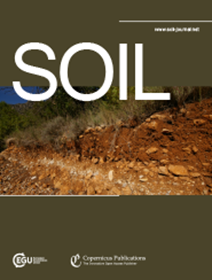Depth-dependence of soil organic carbon additional storage capacity in different soil types by the 2050 target for carbon neutrality
IF 5.8
2区 农林科学
Q1 SOIL SCIENCE
引用次数: 0
Abstract
Abstract. Land planning projects aiming to maximise soil organic carbon (SOC) stocks are increasing in number and scope. In response, a rising number of studies assess SOC additional storage capacities over regional to global spatial scales. In order to provide realistic values transferrable beyond the scientific community, SOC storage capacity assessments should consider the timescales over which this capacity might be reached, considering the effects of C inputs, soil type and depth on soil C dynamics. This research was conducted in a 320 km2 territory in North-eastern France where eight contrasted soil types have been identified, characterized and mapped thanks to a high density of fully-described soil profiles. Continuous profiles of SOC stocks were interpolated for each soil type and land use (cropland, grassland or forest). Depth-dependent estimates of maximum SOC additional storage capacity using the Hassink equation and a data-driven approach were compared. We used a novel method that uses the data-driven approach to constrain C inputs in a simple model of depth-dependent C dynamics to simulate SOC accrual over 25 years, and mapped the SOC stocks, maximum additional storage capacity and stock evolution. SOC stocks and maximum additional storage capacities are highly heterogenous over the region of study. Median SOC stocks range from 78–333 tC ha-1. Data-driven maximum SOC additional storage capacities vary from 19 tC ha-1 in forested Leptosols to 197 tC ha-1 in grassland Gleysols. Estimations of SOC maximum additional storage capacities based on the Hassink approach led to unrealistic vertical distributions of SOC stock, with particular overestimation in the deeper layers. Crucially, the simulated SOC accrual over 25 years was five times lower than the maximum SOC additional storage capacity (0.57 and 2.5 MgC respectively). Further consideration of depth-dependent SOC dynamics in different soil types is therefore needed to provide targets of SOC storage over timescales relevant to public policies aiming to approach carbon neutrality by 2050.到 2050 年实现碳中和目标时,不同土壤类型中土壤有机碳额外储存能力的深度依赖性
摘要旨在最大限度增加土壤有机碳(SOC)储量的土地规划项目越来越多,范围也越来越广。为此,越来越多的研究对区域乃至全球范围内的 SOC 额外储存能力进行了评估。为了提供可在科学界以外转移的实际价值,SOC 储量评估应考虑达到该储量的时间尺度,同时考虑碳输入、土壤类型和深度对土壤碳动态的影响。这项研究在法国东北部一块 320 平方公里的土地上进行,通过高密度的完整土壤剖面描述,确定、描述和绘制了八种不同的土壤类型。针对每种土壤类型和土地利用(耕地、草地或森林),对 SOC 储量的连续剖面进行了插值。我们比较了使用哈辛克方程和数据驱动方法对最大 SOC 附加存储容量进行的深度估算。我们采用了一种新方法,利用数据驱动法在一个简单的依赖深度的碳动态模型中限制碳输入,模拟 25 年的 SOC 累积,并绘制了 SOC 储量、最大额外储存能力和储量演变图。在研究区域内,SOC 储量和最大额外储存能力差异很大。SOC 储量中值范围为 78-333 吨碳/公顷-1。数据驱动的最大 SOC 附加储存能力从森林莱普托土壤中的 19 吨碳/公顷-1 到草地格列斯土壤中的 197 吨碳/公顷-1 不等。根据哈辛克方法估算的 SOC 最大额外储存能力导致 SOC 储量的垂直分布不符合实际情况,尤其是在较深的地层被高估。最重要的是,模拟的 25 年 SOC 累积量比最大 SOC 附加储存能力(分别为 0.57 和 2.5 兆立方厘米)低五倍。因此,需要进一步考虑不同土壤类型中与深度相关的 SOC 动态,以提供与旨在 2050 年实现碳中和的公共政策相关的 SOC 时间尺度存储目标。
本文章由计算机程序翻译,如有差异,请以英文原文为准。
求助全文
约1分钟内获得全文
求助全文
来源期刊

Soil
Agricultural and Biological Sciences-Soil Science
CiteScore
10.80
自引率
2.90%
发文量
44
审稿时长
30 weeks
期刊介绍:
SOIL is an international scientific journal dedicated to the publication and discussion of high-quality research in the field of soil system sciences.
SOIL is at the interface between the atmosphere, lithosphere, hydrosphere, and biosphere. SOIL publishes scientific research that contributes to understanding the soil system and its interaction with humans and the entire Earth system. The scope of the journal includes all topics that fall within the study of soil science as a discipline, with an emphasis on studies that integrate soil science with other sciences (hydrology, agronomy, socio-economics, health sciences, atmospheric sciences, etc.).
 求助内容:
求助内容: 应助结果提醒方式:
应助结果提醒方式:


